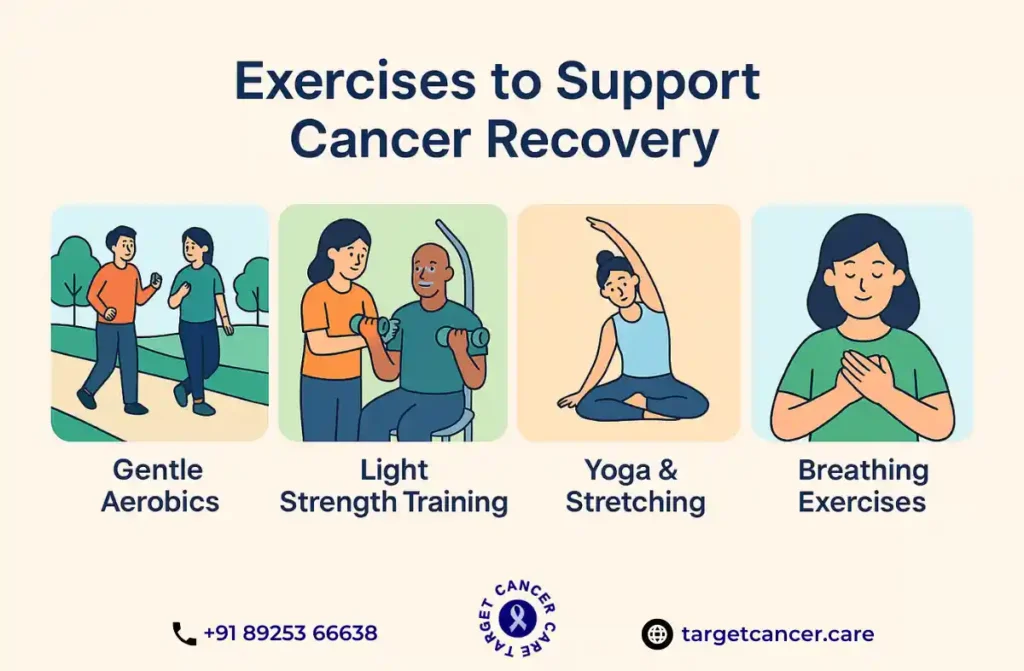Cancer isn’t just a diagnosis—it’s a life-altering journey that reshapes the body, emotions, and day-to-day living. It begins when abnormal cells grow uncontrollably, often overwhelming healthy tissues. For those navigating chemotherapy, radiation, or recovery, regaining strength and a sense of control becomes vital. This is where exercise for cancer patients becomes a powerful ally. Thoughtfully tailored movement isn’t just safe—it helps rebuild energy, improve mood, and support healing in ways medicine alone cannot.
What is physical activity?
Physical activity refers to any movement of the body that uses energy—from gentle stretches to brisk walking or strength exercises. For those facing cancer, including breast cancer, staying active isn’t about intensity—it’s about consistency and intention. Exercise for cancer patients is thoughtfully adapted to match their physical condition and treatment phase, making it a safe and supportive part of their healing.
- Adapted for Healing, Not Performance: Unlike typical fitness routines, exercise for cancer patients is focused on helping the body recover, not pushing limits. Movements may include walking, light resistance training, or balance work—each chosen based on how the patient feels and what their body needs.
- An Anchor During Treatment: During chemotherapy or radiation, the body often feels heavy or unresponsive. Gentle physical activity, such as breast cancer exercise programs involving arm circles or yoga, can reduce stiffness, maintain mobility, and prevent muscle loss without causing strain.
- Supports Mental and Emotional Health: Beyond physical effects, activity helps lift mood, reduce anxiety, and restore a sense of normalcy. Many patients find that short daily walks or breathing exercises give them back a sense of control over their day.
Shaped by how the body feels and heals, physical activity becomes a quiet but powerful part of recovery.
Benefits of Exercise
Engaging in physical activity during and after cancer treatment brings a wide range of benefits that go far beyond physical strength. From emotional resilience to better treatment outcomes, exercise for cancer patients becomes an essential part of comprehensive care. Whether it’s breast cancer exercise routines or the best exercise for lung cancer patients, the benefits can be deeply transformative.
- Reduces Fatigue and Boosts Energy: Fatigue is one of the most common side effects of cancer treatment. Gentle movement, such as stretching or short walks, can improve blood circulation and oxygen flow, helping patients feel more alert and less drained.
- Improves Treatment Tolerance: Exercise may enhance how well the body handles chemotherapy or radiation. Staying physically active keeps muscles engaged, supports cardiovascular function, and reduces the severity of some treatment side effects like nausea or neuropathy.
- Preserves Muscle Mass and Joint Mobility: Cancer treatments can weaken muscles and reduce flexibility. Incorporating strength and flexibility exercises—especially in breast cancer exercise plans—can help maintain mobility and reduce the risk of lymphedema.
- Elevates Mood and Reduces Anxiety: Physical activity releases endorphins, natural mood boosters that can reduce symptoms of depression and anxiety. Even 15 minutes of daily movement can dramatically improve mental well-being for patients.
- Enhances Lung Function and Breathing: For those seeking the best exercise for lung cancer patients, deep breathing techniques combined with slow movements like tai chi or guided yoga can enhance respiratory capacity and reduce breathlessness.
With each session, exercise becomes more than just movement—it becomes a lifeline, a daily ritual of self-care, and a way to reclaim strength.

Can You Exercise With Cancer and After Cancer Treatment?
Absolutely. Movement—when personalized and approached with care—can be both safe and deeply beneficial before, during, and after cancer treatment. Exercise for cancer patients isn’t about pushing boundaries; it’s about listening to the body, staying gently active, and recovering with grace. Whether someone is mid-treatment or in remission, the right physical activity can play a supportive, healing role.
- During Treatment, Choose Gentle Movement: Treatments like chemotherapy can leave the body weak, but even low-intensity activity can help. Short walks, gentle yoga, or breathing exercises for cancer patients can reduce fatigue, improve circulation, and ease mental stress.
- After Treatment, Focus on Rebuilding: Once treatment ends, the body begins a slow process of repair. This is the time to incorporate structured strength-building exercises, balance routines, and deeper breathing practices to regain stability, muscle tone, and lung capacity.
- Tailor to Daily Energy Levels: Cancer recovery isn’t linear—some days are better than others. Patients are encouraged to practice flexibility in their routines. On low-energy days, a few rounds of stretching or focused breathing exercises for cancer patients can be enough to maintain a healing rhythm.
- Stay in Sync with Medical Guidance: Oncologists and physiotherapists often recommend movement as a core part of recovery. Working with professionals ensures the exercise routine supports recovery without interfering with medications or side effects.
Exercise remains a quiet companion in this journey—reliable, adaptable, and healing at every phase.
Why is Being Physically Active Important?
Physical activity plays a critical role in recovery, resilience, and long-term health. For those undergoing treatment or in remission, exercise for cancer patients becomes an essential tool—not just for the body, but for the mind and spirit. Activities like walking, yoga, and breathing exercises for lung cancer patients offer more than temporary relief; they lay the foundation for lasting strength.
- Supports Heart, Lung, and Muscle Health: Treatments can weaken vital organs and reduce endurance. Regular low-impact movement helps maintain heart rate variability, lung function, and muscle tone, allowing the body to better withstand treatment and recover faster.
- Regulates Sleep and Appetite: Many patients experience insomnia or appetite changes. Physical activity—especially gentle evening walks or morning stretches—can help reset circadian rhythms and stimulate healthy hunger cues, improving both rest and nutrition.
- Boosts Immune Response: A consistent exercise routine may help stimulate the immune system, making the body more resilient against infections. Even moderate activities help reduce inflammation and support white blood cell activity.
- Reinforces Emotional Resilience: Exercise for cancer patients often acts as a stabilizing force. It offers structure in a chaotic time, encourages self-care, and provides a natural way to process emotions through physical release.
- Improves Lung Capacity and Breathing Control: Especially for those undergoing breathing exercises for lung cancer patients, regular practice can improve oxygen intake, reduce shortness of breath, and calm anxiety tied to respiratory issues.
Being active isn’t a luxury during cancer—it’s a quiet necessity that supports every system in the body while restoring confidence and a sense of agency.
How Physical Activity Can Help You Cope Better
For many, exercise for cancer patients becomes more than just movement—it’s a coping tool. It offers structure, focus, and emotional relief during an unpredictable journey. Even small efforts can create a meaningful difference in how patients handle the physical and mental weight of treatment.
- Reduces Stress and Promotes Calm: Activities like yoga or walking regulate cortisol levels, helping manage anxiety and fear. For exercise for breast cancer patients, slow movements paired with deep breathing can ease emotional overwhelm.
- Creates a Sense of Routine: A simple daily schedule that includes physical activity gives a sense of control when everything else feels uncertain. Routines offer emotional grounding.
- Connects Mind and Body: Gentle exercise teaches awareness of body sensations. This connection often fosters self-compassion and helps patients recognize their own strength, even in vulnerable moments.
- Offers a Positive Distraction: Focusing on movement provides a break from medical thoughts. It becomes a mental escape where attention shifts from illness to healing, even if just for 15 minutes.
Physical activity is a quiet companion in coping—a source of strength, clarity, and peace.
Other Health Benefits of Physical Activity
Beyond aiding cancer recovery, exercise for cancer patients offers wide-reaching benefits for overall health. It strengthens the body, supports the mind, and nurtures long-term wellness—even well after treatment ends. Whether gentle or moderate, staying active improves many aspects of daily life.
- Protects Bone and Joint Health: Many treatments affect bone density. Low-impact strength exercises or resistance bands help maintain bone mass and joint mobility, reducing the risk of fractures or stiffness.
- Supports Digestive and Metabolic Health: Physical movement improves digestion and prevents constipation—common issues during treatment. It also helps regulate blood sugar and supports healthy metabolism.
- Improves Balance and Coordination: Exercise for cancer patients fitness after treatment includes balance-based activities like tai chi or light aerobics. These reduce the risk of falls and increase physical confidence during recovery.
- Enhances Brain Function: Regular activity boosts circulation to the brain, improving memory, concentration, and focus. This is particularly helpful for patients experiencing “chemo brain” or post-treatment fog.
- Promotes Long-Term Wellness: Incorporating exercise for cancer patients even after remission encourages a healthier lifestyle, reduces the risk of recurrence, and supports lifelong health habits.
The ripple effect of staying active touches every part of the body—encouraging not just healing, but lasting vitality.
When Physical Activity Feels Impossible
There will be days when simply getting out of bed feels like a challenge. Exercise for cancer patients fitness after treatment must be flexible, allowing rest while offering options that match even the lowest energy levels. Movement doesn’t have to be intense—it just needs to be intentional.
- Start with Breathing and Gentle Stretches: On difficult days, begin with seated stretches or mindful breathing. Exercise for breast cancer patients can include slow shoulder rolls and arm raises that ease tension without overexertion.
- Use Bedside or Chair-Based Movements: When standing feels too tiring, try ankle pumps, leg lifts, or neck circles while seated or lying down. These small actions improve circulation and prevent stiffness.
- Let the Body Guide You: Some days require rest more than motion. Honor your limits. Even short moments of movement—like standing and reaching—can keep the body engaged gently.
- Include Visualization Exercises: If movement isn’t possible, mental visualization of exercises can still activate brain-body pathways. This can help maintain a sense of involvement and hope in recovery.
There’s strength in showing up, even when the effort feels small. These quiet choices build resilience one gentle step at a time.
How Much Exercise Should I Do?
There’s no one-size-fits-all answer. The right amount of exercise for cancer patients depends on how the body feels and what stage of treatment or recovery they’re in. Start small and build gradually, focusing on consistency over intensity. Breathing-focused routines and light physical movement are ideal entry points.
- Begin with 10–15 Minutes a Day: For many, a short daily walk or a few simple stretches can be a powerful start. Pair it with breathing exercises for cancer patients to support relaxation and reduce fatigue.
- Incorporate Breathing into Movement: Especially for those with lung conditions, breathing exercises for lung cancer patients like pursed-lip or diaphragmatic breathing can be practiced multiple times a day to improve lung capacity and calm the nervous system.
- Aim for Gentle Variety Each Week: Try to include a mix of movement types—walking, stretching, light resistance—3 to 5 days a week, depending on energy levels. It helps to rotate activities to avoid overuse or boredom.
- Listen and Adjust Daily: Recovery isn’t predictable. Some days call for stillness, while others allow more activity. Track how the body responds and adjust accordingly with compassion.
Progress lies not in duration but in dedication—tiny, thoughtful steps toward strength and balance.
When to Avoid Certain Types of Physical Activity
Not all movements are safe during every phase of treatment. While exercise for cancer patients is generally encouraged, it’s important to know when to pause or modify routines. The goal is to heal—not to push beyond the body’s current capacity.
- After Surgery or During Wound Healing: Avoid high-impact or weight-bearing activities that may strain healing tissues. For breast cancer patients, overhead lifting or arm-heavy exercises should be paused until cleared by a physician.
- If Experiencing Severe Fatigue or Dizziness: On days with extreme tiredness, light stretching or rest-focused breathing exercises for cancer patients are safer than standing routines or walks.
- For Lung Conditions or Breathing Challenges: Avoid cardio-based movements if they cause breathlessness. Instead, focus on seated activities and breathing exercises for lung cancer patients like pursed-lip breathing to improve airflow safely.
- When Immune System Is Compromised: During periods of low white blood cell counts, avoid gyms or public areas where exposure to infection is high. Exercise at home with sanitized equipment or body-weight movement.
- With Bone or Nerve Issues: If cancer affects the bones or nerves, skip activities with fall risks. Replace them with stability-focused routines and professional guidance.
Safe movement starts with awareness—of limits, conditions, and healing pace. Exercise should support recovery, never strain it.
Conclusion
Exercise for cancer patients is not just about rebuilding the body—it’s about reclaiming strength, independence, and hope. Every stretch, breath, and step helps ease pain, uplift the spirit, and guide recovery. Whether you’re a patient, caregiver, or healthcare provider, remember: healing is not a race, but a rhythm—and movement is part of its melody.
Take the first small step. Let movement walk beside you in healing.




